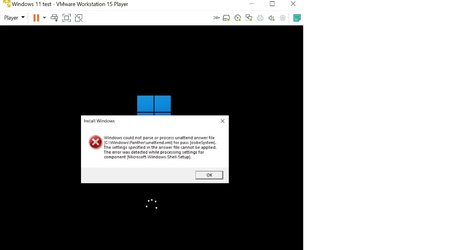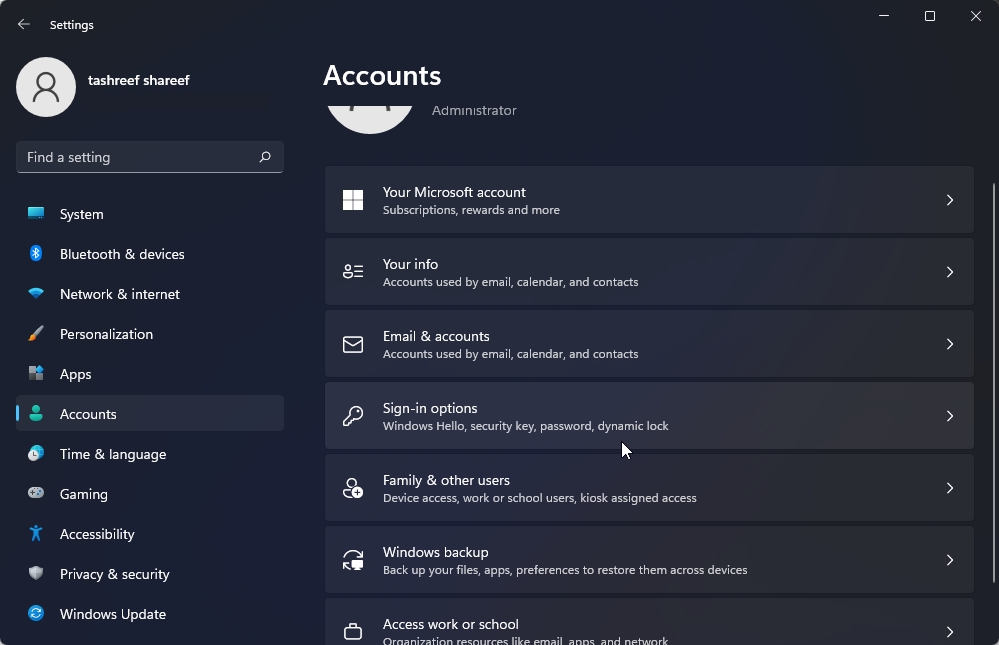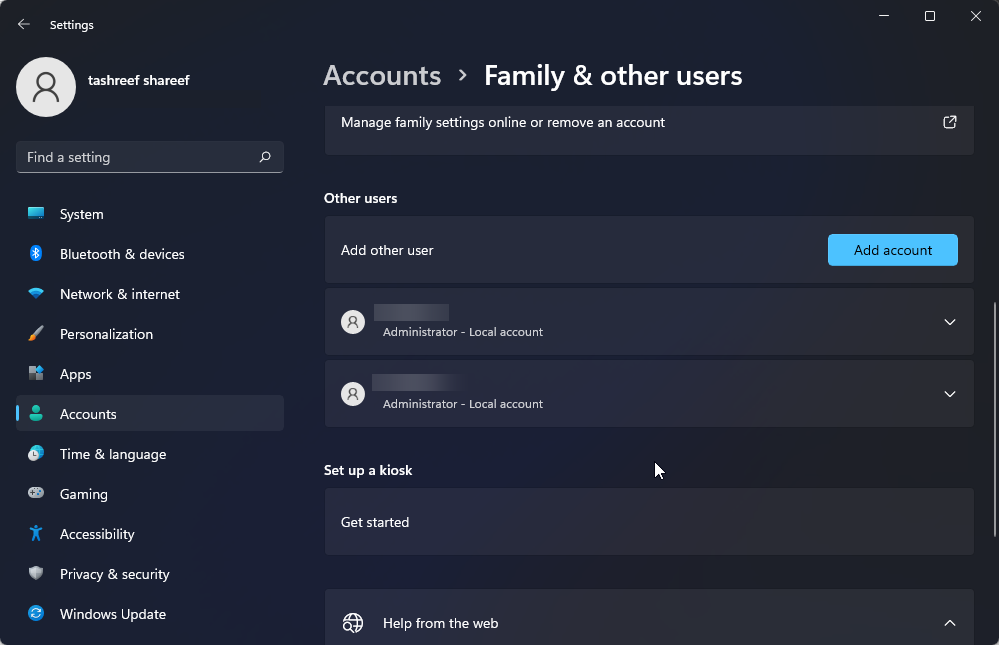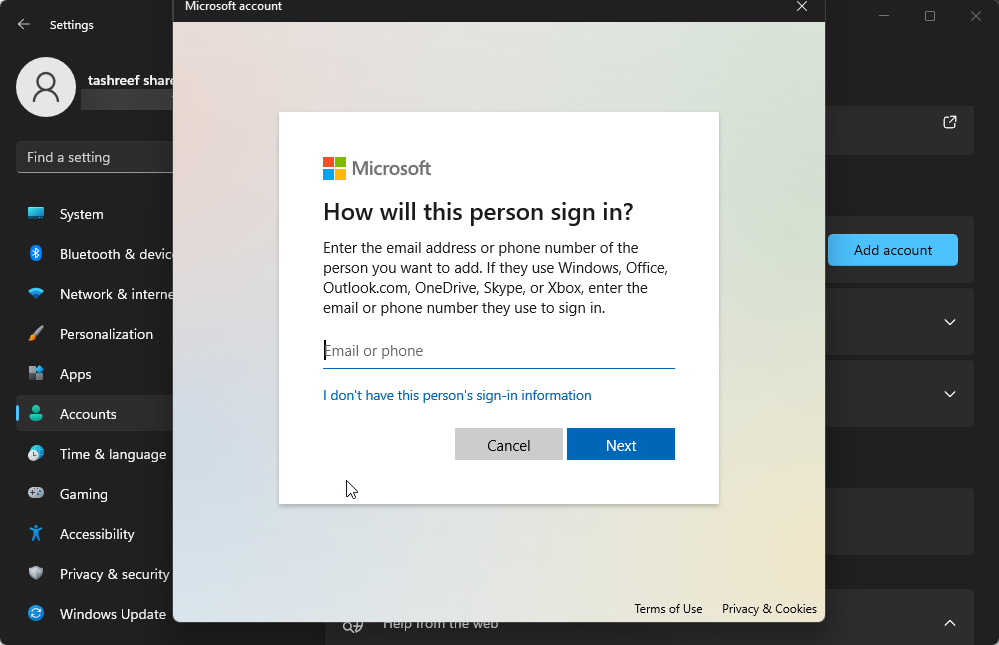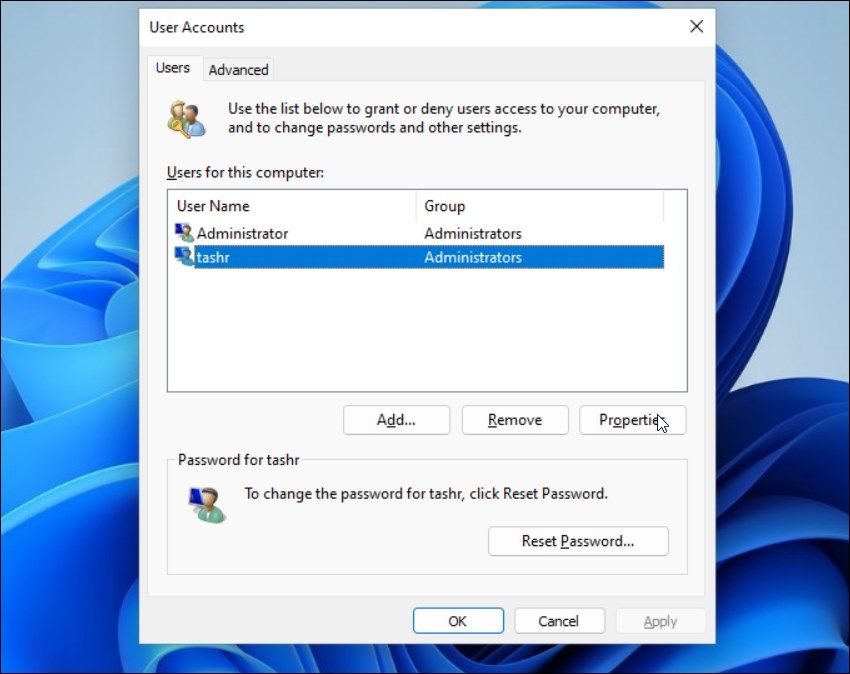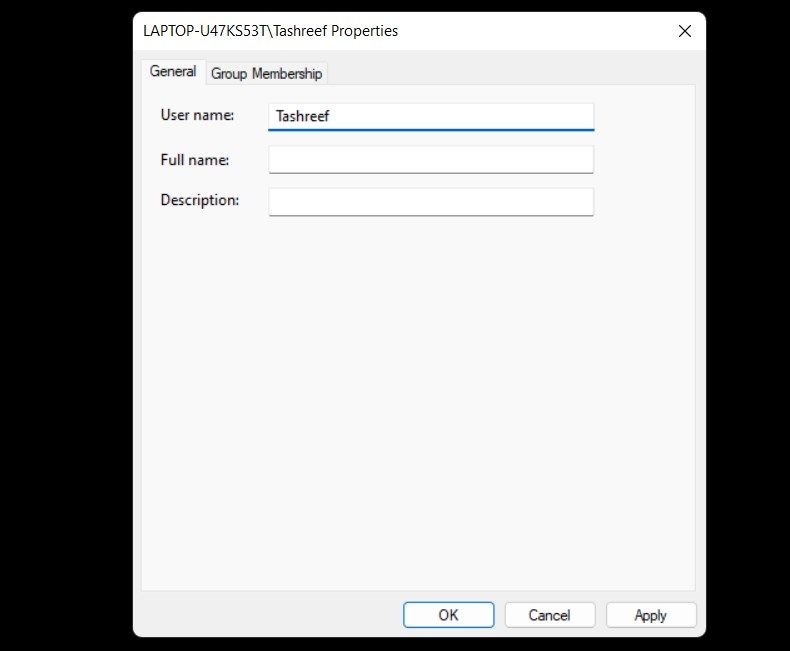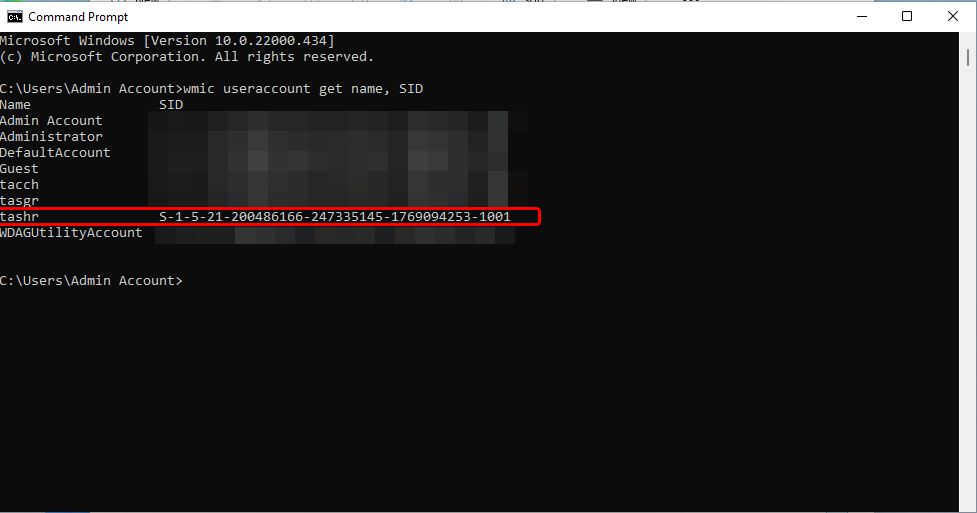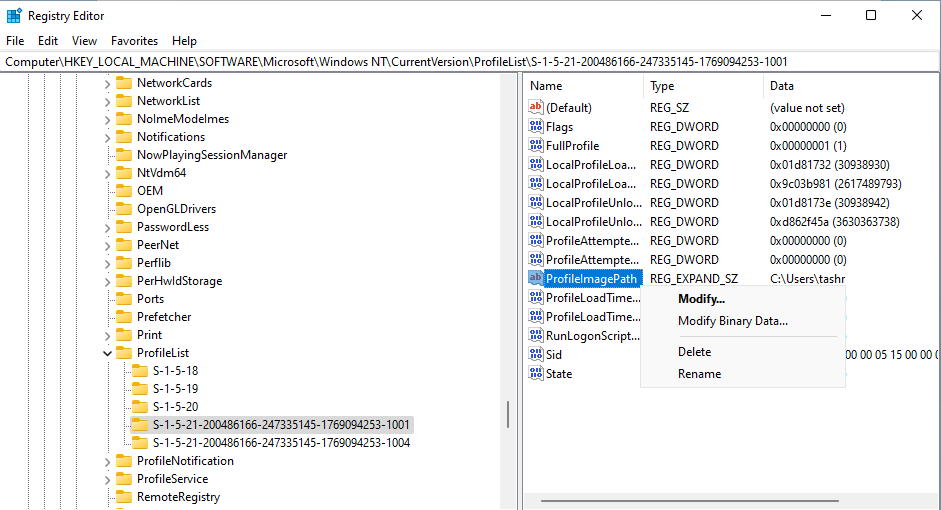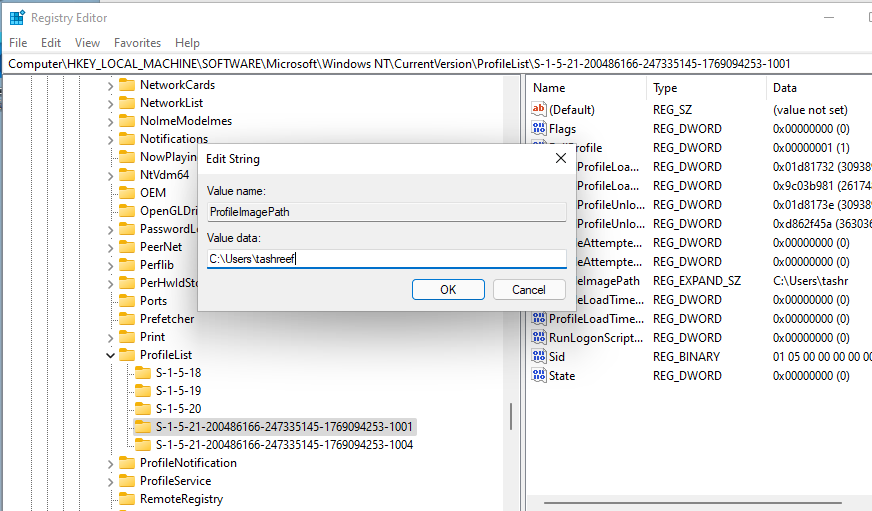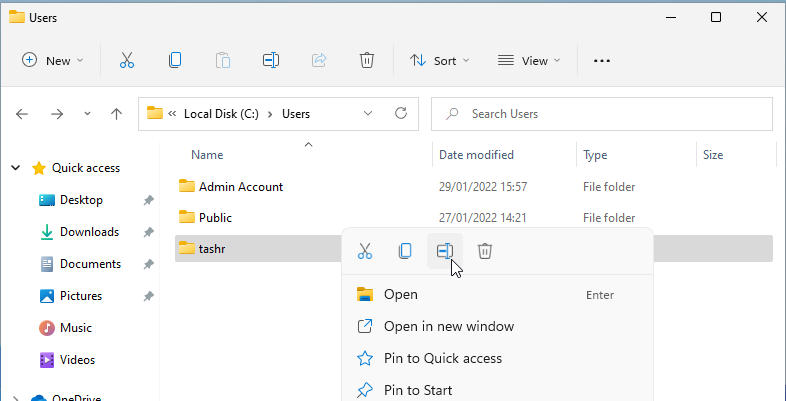7 февраля 2025 г. 17:26
1788
Содержание:
- Важные предупреждения перед началом
- Как переименовать папку пользователя в Виндовс 11: пошаговая инструкция
- Заключение
Многие пользователи Windows 11 сталкиваются с необходимостью смены имени пользовательской папки. Эта папка располагается в C:\Users или C:\Пользователи и создаётся автоматически при регистрации учетной записи. Однако изменить её имя обычными средствами Windows невозможно, поскольку это может привести к сбоям в системе. В этой инструкции рассмотрим безопасные способы как изменить название папки пользователя в Windows 11.
Важные предупреждения перед началом
Перед тем как поменять название папки пользователя в Windows 11, обратите внимание на следующие моменты:
- Создайте точку восстановления системы или резервную копию, чтобы избежать потери данных.
- Не меняйте имя учётной записи Windows — это не приведёт к изменению папки пользователя.
- Некоторые программы могут перестать работать после переименования папки, так как их пути к файлам изменятся.
Учтите, что требуются права администратора для выполнения всех шагов инструкции.
Как переименовать папку пользователя в Виндовс 11: пошаговая инструкция
Чтобы изменить имя папки пользователя, выполните следующие шаги:
1. Включение встроенной учетной записи администратора
Перед переименованием необходимо создать или активировать учётную запись администратора. Это важно, так как стандартный пользователь не имеет достаточных прав для выполнения этой операции. Для этого:
1. Откройте Командную строку (CMD) от имени администратора (через Пуск или комбинацию Win + X → «Терминал (администратор)»).
2. Введите команду: net user Администратор /active:yes
3. Нажмите Enter и перезагрузите компьютер.
4. Войдите в систему под учётной записью «Администратор».
После этого можно приступить к изменению имени папки пользователя.
2. Переименование папки пользователя
Теперь рассмотрим как изменить папку пользователя в Windows 11:
1. Нажмите Win + X и выберите «Управление компьютером».
2. Перейдите в «Локальные пользователи и группы», затем откройте «Пользователи».
3. Найдите нужную учетную запись, щелкните по ней правой кнопкой мыши и выберите «Переименовать». Введите новое имя и нажмите Enter.
4. Откройте Проводник и перейдите в C:\Users (или C:\Пользователи).
5. Найдите папку с именем, которое нужно изменить, щелкните по ней правой кнопкой мыши, выберите «Переименовать», введите новое имя и нажмите Enter.
Теперь папка пользователя будет отображаться с новым именем, но система всё ещё использует старый путь в реестре.
3. Изменение пути к папке в реестре
После переименования папки требуется обновить пути в системном реестре. Без этого шага система может не обнаружить профиль пользователя, что приведёт к ошибкам при входе. Вот как это сделать:
- Откройте редактор реестра (Win + R, затем введите regedit и нажмите Enter).
- Перейдите по пути: HKEY_LOCAL_MACHINE\SOFTWARE\Microsoft\Windows NT\CurrentVersion\ProfileList
- В списке ключей найдите папку, содержащую параметр ProfileImagePath.
- Дважды щёлкните по ProfileImagePath и измените путь, указав новое имя папки.
После этого система должна корректно работать с новым именем папки пользователя.
4. Отключение встроенной учётной записи администратора
После успешного изменения имени папки отключите временную учётную запись администратора:
- Откройте командную строку от имени администратора.
- Введите команду: net user Администратор /active:no
- Перезагрузите систему и войдите в свою учётную запись.
Теперь изменения завершены, и можно продолжать использовать систему с новым именем папки.
Как сменить имя папки пользователя в Windows 11 Домашняя
В версиях Windows 11 Home отсутствует редактор «Локальные пользователи и группы», поэтому необходимо использовать альтернативный метод. Этот способ позволит добиться аналогичного результата без необходимости доступа к расширенным инструментам управления:
- Активируйте учётную запись администратора.
- Переименуйте папку пользователя в проводнике.
- Обновите пути в реестре:
- Откройте редактор реестра.
- Перейдите в HKEY_LOCAL_MACHINE\SOFTWARE\Microsoft\Windows NT\CurrentVersion\ProfileList.
- Обновите значение ProfileImagePath, заменив старый путь на новый.
После этого система должна корректно работать, и папка пользователя будет переименована.
Заключение
Теперь вы знаете, как поменять имя папки пользователя в Windows 11. Если всё сделано правильно, система продолжит работать без ошибок. При возникновении проблем можно восстановить систему из резервной копии или точки восстановления. Если вам требуется чистая установка Windows 11, вы можете скачать актуальный оригинальный образ системы и активировать ОС лицензионным ключом, который можно приобрести ЗДЕСЬ по очень низкой цене. Процесс покупки до получения лицензии составляет 2-3 минуты.
-
Windows Support Forums
-
Installation, Updates and Activation
You should upgrade or use an alternative browser.
Move Users Folder Location in Windows 11
-
Thread starter
Thread startertops
-
Start date
Start date
tops
Well-known member
-
-
#1
Has anyone tried to install Windows 11 by moving the «users» folder out of place, like in this @Kari tutorial?
Another question: I was in the leaked build, I signed up for Windows Insider and with that, via Windows Update, I downloaded the new build and updated. Is it possible to generate an ISO with these files already downloaded or should I download again using UUP DUMP, for example? What do you recommend?
Are any of you using Windows 11 «productively» already, although we know it’s not recommended? I ask this because my Windows 10 installation is unstable (I use it since the first RTM build just updating) and if I were to reinstall, I would do it with Windows 11.
Hugs!!
My Computer
-
- OS
- Windows 11
- Computer type
- PC/Desktop
- CPU
- Intel Core i7 6700 @ 3.40GHz Skylake Tecnology 14 nm
- Motherboard
- Gigabyte Technology Co. Ltd. B150M-D3H DDR3-CF (U3E1)
- Memory
- 16,0GB Single-Channel DDR3 @ 800 Mhz (11-11-11-28)
- Graphics Card(s)
- 4096MB ATI Radeon RX 580 Series (Gigabyte)
- Sound Card
- Realtek High Definition Audio
- Monitor(s) Displays
- SAMSUNG S22E310
- Screen Resolution
- (1920×1080@60Hz)
- Hard Drives
- 931GB Seagate ST1000LM024 HN-M101MBB (SATA )
931GB Seagate ST1000LM024 HN-M101MBB (SATA )
465GB Samsung SSD 980 500GB (Desconhecido (SSD))
2794GB Seagate Expansion Desk USB Device (USB (SATA) )
- PSU
- Seventeam
- Case
- Nilko
- Keyboard
- Logitech
- Mouse
- Logitech M90
- Internet Speed
- 600 / 300 mbps
- Browser
- MS Edge / Google Chrome
- Antivirus
- Windows Defender
Kari
PhD in Malt Based Liquids
-
-
#2

Kari
My Computers
-
- OS
- Windows 11 PRO x64 Dev
- Manufacturer/Model
- Hyper-V Virtual Machine (host in System 2 specs)
- CPU
- Intel Core i7-8550U
- Memory
- 6 GB
- Graphics Card(s)
- Microsoft Hyper-V Video
- Monitor(s) Displays
- Laptop display (17.1″) & Samsung U28E590 (27.7″)
-
- Operating System
- Windows 11 PRO x64 Dev Channel
- Computer type
- Laptop
- Manufacturer/Model
- HP HP ProBook 470 G5
- CPU
- Intel Core i7-8550U
- Motherboard
- HP 837F KBC Version 02.3D.00
- Memory
- 16 GB
- Graphics card(s)
- Intel(R) UHD Graphics 620 & NVIDIA GeForce 930MX
- Sound Card
- Conexant ISST Audio
- Monitor(s) Displays
- Laptop display (17.1″) & Samsung U28E590 (27.7″)
- Hard Drives
- 128 GB SSD & 1 TB HDD
- Mouse
- Wireless Logitech MSX mouse
- Keyboard
- Wireless Logitech MK710 keyboard
- Internet Speed
- 100 Mbps down, 20 Mbps up
- Browser
- Edge Chromium Dev Channel
- Antivirus
- Windows Defender
- Other Info
- 2 * 3 TB USB HDD
6 TB WD Mirror NAS
- Local time
- 11:31 PM
- Posts
- 5,295
- Location
-
3rd Rock
- OS
- Windows 11 23H2 Current build
-
-
#3
\Users moved to a separate physical drive to WIn11 with no issues — other than being slow as #$%@#$%@#$% when upgrading via WU.
My Computers
-
- OS
- Windows 11 23H2 Current build
- Computer type
- PC/Desktop
- Manufacturer/Model
- HomeBrew
- CPU
- AMD Ryzen 9 3950X
- Motherboard
- MSI MEG X570 GODLIKE
- Memory
- 4 * 32 GB — Corsair Vengeance 3600 MHz
- Graphics Card(s)
- EVGA GeForce RTX 3080 Ti XC3 ULTRA GAMING (12G-P5-3955-KR)
- Sound Card
- Realtek® ALC1220 Codec
- Monitor(s) Displays
- 2x Eve Spectrum ES07D03 4K Gaming Monitor (Matte) | Eve Spectrum ES07DC9 4K Gaming Monitor (Glossy)
- Screen Resolution
- 3x 3840 x 2160
- Hard Drives
- 3x Samsung 980 Pro NVMe PCIe 4 M.2 2 TB SSD (MZ-V8P2T0B/AM) } 3x Sabrent Rocket NVMe 4.0 1 TB SSD (USB)
- PSU
- PC Power & Cooling’s Silencer Series 1050 Watt, 80 Plus Platinum
- Case
- Fractal Design Define 7 XL Dark ATX Full Tower Case
- Cooling
- Arctic Liquid Freezer III 420 RGB + Air 3x 140mm case fans (pull front) + 1x 120 mm (push back) and 1 x 120 mm (pull bottom)
- Keyboard
- SteelSeries Apex Pro Wired Gaming Keyboard
- Mouse
- Logitech MX Master 3S | MX Master 3 for Business
- Internet Speed
- AT&T LightSpeed Gigabit Duplex Ftth
- Browser
- Nightly (default) + Firefox (stable), Chrome, Edge , Arc
- Antivirus
- Defender + MB 5 Beta
-
- Operating System
- ChromeOS Flex Dev Channel (current)
- Computer type
- Laptop
- Manufacturer/Model
- Dell Latitude E5470
- CPU
- Intel(R) Core(TM) i5-6300U CPU @ 2.40GHz, 2501 Mhz, 2 Core(s), 4 Logical Processor(s)
- Motherboard
- Dell
- Memory
- 16 GB
- Graphics card(s)
- Intel(R) HD Graphics 520
- Sound Card
- Intel(R) HD Graphics 520 + RealTek Audio
- Monitor(s) Displays
- Dell laptop display 15″
- Screen Resolution
- 1920 * 1080
- Hard Drives
- Toshiba 128GB M.2 22300 drive
INTEL Cherryville 520 Series SSDSC2CW180A 180 GB SATA III SSD
- PSU
- Dell
- Case
- Dell
- Cooling
- Dell
- Mouse
- Logitech MX Master 3S (shared w. Sys 1) | Dell TouchPad
- Keyboard
- Dell
- Internet Speed
- AT&T LightSpeed Gigabit Duplex Ftth
- Local time
- 5:31 AM
- Posts
- 260
- OS
- Windows 10
-
-
#4
My Computer
-
- OS
- Windows 10
- Computer type
- PC/Desktop
- CPU
- i5-10600K
- Motherboard
- Asus Rog Strix Z490-A Gaming
- Memory
- 16 GB
- Graphics Card(s)
- GeForce GTX 1650
- Monitor(s) Displays
- Samsung U32J59x 32″ 4K
- Screen Resolution
- 3840×2160
Kari
PhD in Malt Based Liquids
-
-
#5
Any reason you need to put your files in the /Users folders?
It’s not about where to store personal files, it’s about where to store ALL user profile related files. One simple and fast procedure while installing Windows, and all future user accounts created will store their user profile folders on another drive than Windows system drive.
It does automatically the same to all users profiles, than you do manually separately for each user, just better. I mean, you change the storage location for your docs, pics, music and whatever, but the method discussed in this thread moves all of those, plus anything related to user profiles. The more accounts you have, the more you gain.
A good example is AppData folders. Mine is currently over 20 GB. In addition, I have three other accounts, each around 10 GB AppData. Moving the whole Users folder to another disk, E: drive in my case, has already saved over 50 GB from C: drive, in addition to all personal data for all user accounts will be automatically saved to E:, no reason to change anything manually.
Kari
My Computers
-
- OS
- Windows 11 PRO x64 Dev
- Manufacturer/Model
- Hyper-V Virtual Machine (host in System 2 specs)
- CPU
- Intel Core i7-8550U
- Memory
- 6 GB
- Graphics Card(s)
- Microsoft Hyper-V Video
- Monitor(s) Displays
- Laptop display (17.1″) & Samsung U28E590 (27.7″)
-
- Operating System
- Windows 11 PRO x64 Dev Channel
- Computer type
- Laptop
- Manufacturer/Model
- HP HP ProBook 470 G5
- CPU
- Intel Core i7-8550U
- Motherboard
- HP 837F KBC Version 02.3D.00
- Memory
- 16 GB
- Graphics card(s)
- Intel(R) UHD Graphics 620 & NVIDIA GeForce 930MX
- Sound Card
- Conexant ISST Audio
- Monitor(s) Displays
- Laptop display (17.1″) & Samsung U28E590 (27.7″)
- Hard Drives
- 128 GB SSD & 1 TB HDD
- Mouse
- Wireless Logitech MSX mouse
- Keyboard
- Wireless Logitech MK710 keyboard
- Internet Speed
- 100 Mbps down, 20 Mbps up
- Browser
- Edge Chromium Dev Channel
- Antivirus
- Windows Defender
- Other Info
- 2 * 3 TB USB HDD
6 TB WD Mirror NAS
JAM83
iRacing Broadcaster for MaxspeedTV
- Local time
- 10:31 PM
- Posts
- 1,584
- Location
-
Mulberry, Arkansas
- OS
- Windows 11 Pro x64 24H2 v26100.3037
-
-
#6
I am not sure I understand why people bother with this. I keep my personal files (i.e., any files that are not the OS or installed programs) on a separate drive. They are not in the /Users folders and I never noticed any problem. Any reason you need to put your files in the /Users folders?
Same here! I have a 4TB extra HDD I used for extra stuff. I don’t save anything in Documents or Downloads just in case i have a crash or something.
My Computers
-
- OS
- Windows 11 Pro x64 24H2 v26100.3037
- Computer type
- PC/Desktop
- Manufacturer/Model
- Built Myself in 2017
- CPU
- AMD Ryzen 1800X 8-Core @ 3.60GHz
- Motherboard
- Asus Crosshair VI Hero
- Memory
- 16GB G.Skill Trident Z RGB Series
- Graphics Card(s)
- EVGA GeForce gtx 1660 Super
- Sound Card
- On Board
- Monitor(s) Displays
- 2 X AOC 27″ , PLANAR 22″
- Screen Resolution
- 1920 X 1080
- Hard Drives
- ~~~~~~~~~~~~~~~~~~~~~~~~~~
~ P34A60 512GB NVMe PCIe Gen3x4 M.2
~ 6TB Toshiba HDD
~ 6TB HDD (Backup)
~ SanDisk 250GB SSD
~ 2 X 1TB HDD
~~~~~~~~~~
- PSU
- Corsair RM850 Fully Modular (850watts)
- Case
- NZXT Phantom 630 CA-PH630-W1
- Cooling
- CORSAIR iCUE H100i RGB PRO XT
- Keyboard
- Nulea RT05 Wireless Ergonomic
- Mouse
- Nulea MD280 Wireless Vertical Mouse
- Internet Speed
- 761Mbps (Download) / 692Mbps (Upload)
- Browser
- Firefox
- Antivirus
- Malwarebytes
- Other Info
- *This is my Main Computer That I use*
-
- Operating System
- Windows 11 Pro x64 24H2 v26100.2894
- Computer type
- PC/Desktop
- Manufacturer/Model
- HP
- CPU
- Intel Xeon E3-1246 v3 @ 3.50GHz
- Memory
- 16GB
- Graphics card(s)
- AMD Radeon R7 350X
- Sound Card
- onBoard
- Monitor(s) Displays
- eMachine 22″
- Screen Resolution
- 1920 X 1080
- Hard Drives
- 250GB SSD
- Cooling
- Fan
- Mouse
- Nulea MD280
- Internet Speed
- 752Mbps (Download) / 537Mbps (Upload)
- Browser
- Firefox
- Antivirus
- Malwarebytes
- Other Info
- I use this computer for photo/video editing and to track severe weather
-
-
#7
My Computers
-
- OS
- Windows 11 Pro
- Computer type
- PC/Desktop
- Manufacturer/Model
- Self Built
- CPU
- Ryzen 9 3900x
- Motherboard
- Asus Strix x570-E
- Memory
- Corsair Dominator Platinum 32Gb@3600MHz
- Graphics Card(s)
- Asus Strix 3080 Ti OC
- Monitor(s) Displays
- Samsung Odyssey G7 32″ Curved Gaming Monitor, IIYAMA XUB2792QSU-W1 27″
- Screen Resolution
- 2560×1440@240Hz, 2560×1440@70Hz
- Hard Drives
- Samsung 980 Pro 1 Tb (OS), Samsung 970 Pro 1 Tb (games), Samsung 860 Evo 1Tb (data), Samsung 860 Evo 4 Tb (games), Crucial MX500 1Tb (photos), Synology DS920+ 32 Tb NAS.
- PSU
- Corsair RM850x
- Case
- Corsair Crystal 680x
- Cooling
- Corsair H100i Se Platinum, 8 Corsair QL120/140 fans
- Keyboard
- Corsair K70 RGB Mk 2 SE Rapid Fire
- Mouse
- Corsair M65 Elite
- Internet Speed
- 58/12 Mbps
- Browser
- Microsoft Edge
- Antivirus
- Windows Defender + Malwarebytes
- Other Info
- Astro a50 Headset, Samsung Galaxy Tab S3 Tablet.
Creative T6300 5.1 Speakers. TPM 2.0 Module.
-
- Operating System
- Arch Linux KDE
- Computer type
- PC/Desktop
- Manufacturer/Model
- Self Built
- CPU
- Ryzen 5600x
- Motherboard
- Asus Strix B550-E
- Memory
- Corsair Vengeance 32Gb@3200MHz
- Graphics card(s)
- Gigabyte RTX2070 Super Gaming OC
- Sound Card
- Creative Soundblaster AE-5
- Monitor(s) Displays
- Asus Strix XG43VQ 43″ Ultrawide
- Screen Resolution
- 3840×1200 @ 120Mhz
- Hard Drives
- Aorus Gen 4 NVMe 1 Tb (Windows Insider), Samsung 850 Pro 512Gb (data), Samsung 850 Evo 1Tb (backups), Samsung 860 Evo 2Tb (Home folder), Blu-ray player
- PSU
- Corsair RM750i
- Case
- Fractal Define R6
- Cooling
- Scythe Mugen 5 rev B and Corsair QL fans
- Mouse
- Glorious Model D
- Keyboard
- Corsair K70 RGB MK.2 Low Profile Rapidfire
- Internet Speed
- 58/12 Mbps
- Browser
- Microsoft Edge
- Antivirus
- Windows Defender + Malwarebytes
- Other Info
- Corsair Virtuoso Headset
- Local time
- 11:31 PM
- Posts
- 5,295
- Location
-
3rd Rock
- OS
- Windows 11 23H2 Current build
-
-
#8
The main advantage of storing your files away from C: is if Windows develops a problem, you can simply format and your files will be intact.
^^^^^^.
Even if my system drive crashes, All of the data is not on the system drive — thus saved.
And I don’t mean just documents, photos, etc. I mean settings for app, everything in AppData, all profiles, etc.
Honestly, I don’t see why people don’t do this. I make regular backups of the drive that has \Users — which is all the important stuff. I don’t bother with the system drive because I can easily install everything I need in short order.
But having that separate drive for all of \Users makes it a ton easier to get back to where you were before.
Perfect example: When I clean install Windows, I have my backup of the D: drive (which is where \Users resides). But I then also copy my profile to E:. It includes things like all my browser profiles (addons, content, saved sites, customizations, etc.) — I then format the 2 NVMe drives, install to NVMe01 (C) and then use Kar’s tutorial to move \Users to NVMe02 (D), then I can install my apps. But after I copy back things from AppData, like the Google folder, the Microsoft folder (selectively, there are things you don’t want to copy back, like crypto stuff — not cryptocurrency, cryptology (?) used by Microsoft apps) and Mozilla, each and every Browser I was using before is back exactly the same as before I formatted. Same exact addons, same exact settings, same exact websites last opened — because it is the same exact profile.
Same applies to ~65% of my apps. The rest are either saving files and settings in the cloud (like games) or I don’t actually care for.
And this way, I can have 700 GB of games installed but not have to tailor my backup to exclude folders and such, because C:, where programs get installed, doesn’t get imaged — really no need to. My data is what is important, not my apps.
It makes getting a system back up and running after a chosen clean install much, much faster.
And if you another of Kari’s tutorial on how ot build a system image of your system including the apps, it becomes even that much faster — load image, copy fodlers from \AppData and poof — you’re right back where you were in no time.
My Computers
-
- OS
- Windows 11 23H2 Current build
- Computer type
- PC/Desktop
- Manufacturer/Model
- HomeBrew
- CPU
- AMD Ryzen 9 3950X
- Motherboard
- MSI MEG X570 GODLIKE
- Memory
- 4 * 32 GB — Corsair Vengeance 3600 MHz
- Graphics Card(s)
- EVGA GeForce RTX 3080 Ti XC3 ULTRA GAMING (12G-P5-3955-KR)
- Sound Card
- Realtek® ALC1220 Codec
- Monitor(s) Displays
- 2x Eve Spectrum ES07D03 4K Gaming Monitor (Matte) | Eve Spectrum ES07DC9 4K Gaming Monitor (Glossy)
- Screen Resolution
- 3x 3840 x 2160
- Hard Drives
- 3x Samsung 980 Pro NVMe PCIe 4 M.2 2 TB SSD (MZ-V8P2T0B/AM) } 3x Sabrent Rocket NVMe 4.0 1 TB SSD (USB)
- PSU
- PC Power & Cooling’s Silencer Series 1050 Watt, 80 Plus Platinum
- Case
- Fractal Design Define 7 XL Dark ATX Full Tower Case
- Cooling
- Arctic Liquid Freezer III 420 RGB + Air 3x 140mm case fans (pull front) + 1x 120 mm (push back) and 1 x 120 mm (pull bottom)
- Keyboard
- SteelSeries Apex Pro Wired Gaming Keyboard
- Mouse
- Logitech MX Master 3S | MX Master 3 for Business
- Internet Speed
- AT&T LightSpeed Gigabit Duplex Ftth
- Browser
- Nightly (default) + Firefox (stable), Chrome, Edge , Arc
- Antivirus
- Defender + MB 5 Beta
-
- Operating System
- ChromeOS Flex Dev Channel (current)
- Computer type
- Laptop
- Manufacturer/Model
- Dell Latitude E5470
- CPU
- Intel(R) Core(TM) i5-6300U CPU @ 2.40GHz, 2501 Mhz, 2 Core(s), 4 Logical Processor(s)
- Motherboard
- Dell
- Memory
- 16 GB
- Graphics card(s)
- Intel(R) HD Graphics 520
- Sound Card
- Intel(R) HD Graphics 520 + RealTek Audio
- Monitor(s) Displays
- Dell laptop display 15″
- Screen Resolution
- 1920 * 1080
- Hard Drives
- Toshiba 128GB M.2 22300 drive
INTEL Cherryville 520 Series SSDSC2CW180A 180 GB SATA III SSD
- PSU
- Dell
- Case
- Dell
- Cooling
- Dell
- Mouse
- Logitech MX Master 3S (shared w. Sys 1) | Dell TouchPad
- Keyboard
- Dell
- Internet Speed
- AT&T LightSpeed Gigabit Duplex Ftth
-
-
#9
My Computers
-
- OS
- Windows 11 Pro
- Computer type
- PC/Desktop
- Manufacturer/Model
- Self Built
- CPU
- Ryzen 9 3900x
- Motherboard
- Asus Strix x570-E
- Memory
- Corsair Dominator Platinum 32Gb@3600MHz
- Graphics Card(s)
- Asus Strix 3080 Ti OC
- Monitor(s) Displays
- Samsung Odyssey G7 32″ Curved Gaming Monitor, IIYAMA XUB2792QSU-W1 27″
- Screen Resolution
- 2560×1440@240Hz, 2560×1440@70Hz
- Hard Drives
- Samsung 980 Pro 1 Tb (OS), Samsung 970 Pro 1 Tb (games), Samsung 860 Evo 1Tb (data), Samsung 860 Evo 4 Tb (games), Crucial MX500 1Tb (photos), Synology DS920+ 32 Tb NAS.
- PSU
- Corsair RM850x
- Case
- Corsair Crystal 680x
- Cooling
- Corsair H100i Se Platinum, 8 Corsair QL120/140 fans
- Keyboard
- Corsair K70 RGB Mk 2 SE Rapid Fire
- Mouse
- Corsair M65 Elite
- Internet Speed
- 58/12 Mbps
- Browser
- Microsoft Edge
- Antivirus
- Windows Defender + Malwarebytes
- Other Info
- Astro a50 Headset, Samsung Galaxy Tab S3 Tablet.
Creative T6300 5.1 Speakers. TPM 2.0 Module.
-
- Operating System
- Arch Linux KDE
- Computer type
- PC/Desktop
- Manufacturer/Model
- Self Built
- CPU
- Ryzen 5600x
- Motherboard
- Asus Strix B550-E
- Memory
- Corsair Vengeance 32Gb@3200MHz
- Graphics card(s)
- Gigabyte RTX2070 Super Gaming OC
- Sound Card
- Creative Soundblaster AE-5
- Monitor(s) Displays
- Asus Strix XG43VQ 43″ Ultrawide
- Screen Resolution
- 3840×1200 @ 120Mhz
- Hard Drives
- Aorus Gen 4 NVMe 1 Tb (Windows Insider), Samsung 850 Pro 512Gb (data), Samsung 850 Evo 1Tb (backups), Samsung 860 Evo 2Tb (Home folder), Blu-ray player
- PSU
- Corsair RM750i
- Case
- Fractal Define R6
- Cooling
- Scythe Mugen 5 rev B and Corsair QL fans
- Mouse
- Glorious Model D
- Keyboard
- Corsair K70 RGB MK.2 Low Profile Rapidfire
- Internet Speed
- 58/12 Mbps
- Browser
- Microsoft Edge
- Antivirus
- Windows Defender + Malwarebytes
- Other Info
- Corsair Virtuoso Headset
- Local time
- 11:31 PM
- Posts
- 9,517
- OS
- Windows 11 Pro x64
-
-
#10
I am not sure I understand why people bother with this. I keep my personal files (i.e., any files that are not the OS or installed programs) on a separate drive. They are not in the /Users folders and I never noticed any problem. Any reason you need to put your files in the /Users folders?
Some user data you have no control over the location — it goes into appdata for instance. I have a separate partition on the same nvme drive as windows that I keep my user data on. I use the built in Windows settings for relocation of User Photos, documents, pictures etc. folders to that partition, and I create junctions in appdata for Mozilla Firefox, Thunderbird, and Edge profiles to that partition. I do this for backup purposes. — I don’t care about any other user data in appdata I backup the Windows partition with Macrium Reflect, and sync the User data to external drives with robocopy. I can update windows, and back it up, without having to worry about my user data, including Mozilla profiles. I have the user data sync with robocopy automated with powershell scripts. This works well for me.
I don’t just relocate the whole user folder since appdata contains lots of windows stuff that I think belongs with the Windows backup.
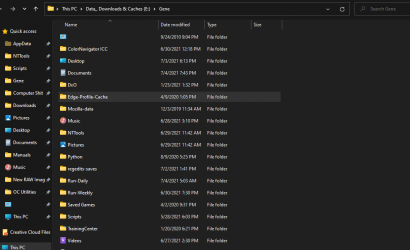
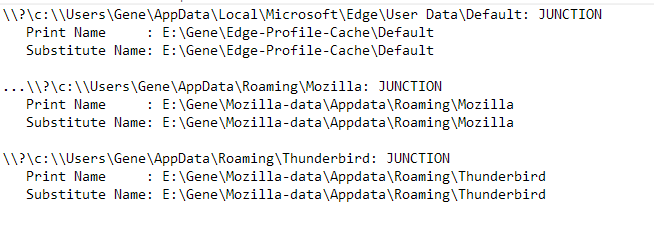
My Computers
-
- OS
- Windows 11 Pro x64
- Computer type
- PC/Desktop
- Manufacturer/Model
- DIY Photoshop/Audio/Game/tinker build
- CPU
- Intel i9 13900KS P/E cores 5.7/4.4 GHz, cache 5.0 GHz
- Motherboard
- Asus ROG Maximus Z790 Dark Hero
- Memory
- 96GB (2×48) G.skill Ripjaws 6800 MT/s
- Graphics Card(s)
- Asus ROG Strix 4070 Ti OC
- Sound Card
- Bowers & Wilkins 606 S3 speakers; Audiolabs 7000a integrated amp; Logan Martin Sub; Creative Pebble Pro Minimilist
- Monitor(s) Displays
- Eizo CG2730 ColorEdge, ViewSonic VP2768
- Screen Resolution
- 2560 x 1440p x 2
- Hard Drives
- WDC SN850X 4TB nvme, SN850 1TB nvme, SK-Hynix 2 TB P41 nvme,. Sabrent USB-C DS-SC5B 5-bay docking station: 6TB WDC Black, 6TB Ironwolf Pro; 2x 2TB WDC Black HDD
- PSU
- 850W Seasonic Vertex PX-850 ATX 3.0/PCI-E 5.0
- Case
- Fractal Design North XL Mesh, Black Walnut
- Cooling
- EKWB 360 Nucleus Dark AIO w/Phanteks T30-120 fans, 1 Noctua NF-A14 Chromax case fan, 1 T30-120 fan cooling memory
- Keyboard
- Keychron Q3 Max TKL with custom GMK Redsuns Red Samuri keycaps, TX Stabs
- Mouse
- Logitech G305 wireless gaming
- Internet Speed
- 500 Mb/s down, 12 Mb/s up
- Browser
- Firefox
- Antivirus
- Defender, Macrium Reflect X
- Other Info
- Runs hot. LOL. SP: P116/E93/M93
Phangkey Amaterasu V2 Desk Mat
-
- Computer type
- Laptop
- Manufacturer/Model
- Apple 13″ Macbook Pro 2020 (m1)
- CPU
- Apple M1
- Screen Resolution
- 2560×1600
- Browser
- Firefox
- Local time
- 10:31 AM
- Posts
- 1,096
- OS
- Microsoft Windows 11 Home
-
-
#11
Set-ItemProperty -Path «HKLM:\SOFTWARE\Policies\Microsoft\Edge» -Name «UserDataDir» -Type String -Value «D:\Documents\Edge»
Set-ItemProperty -Path «HKLM:\SOFTWARE\Policies\Microsoft\Edge» -Name «DiskCacheDir» -Type String -Value «E:\Temp\Edge»
My Computer
-
- OS
- Microsoft Windows 11 Home
- Computer type
- PC/Desktop
- Manufacturer/Model
- MSI MS-7D98
- CPU
- Intel Core i5-13490F
- Motherboard
- MSI B760 GAMING PLUS WIFI
- Memory
- 2 x 16 Patriot Memory (PDP Systems) PSD516G560081
- Graphics Card(s)
- GIGABYTE GeForce RTX 4070 WINDFORCE OC 12G (GV-N4070WF3OC-12GD)
- Sound Card
- Bluetooth Аудио
- Monitor(s) Displays
- INNOCN 15K1F
- Screen Resolution
- 1920 x 1080
- Hard Drives
- WD_BLACK SN770 250GB
KINGSTON SNV2S1000G (ELFK0S.6)
- PSU
- Thermaltake Toughpower GF3 1000W
- Case
- CG560 — DeepCool
- Cooling
- ID-COOLING SE-224-XTS / 2 x 140Mm Fan — rear and top; 3 x 120Mm — front
- Keyboard
- Corsair K70 RGB TKL
- Mouse
- Corsair KATAR PRO XT
- Internet Speed
- 100 Mbps
- Browser
- Firefox
- Antivirus
- Microsoft Defender Antivirus
- Other Info
- https://www.userbenchmark.com/UserRun/66553205
- Local time
- 11:31 PM
- Posts
- 9,517
- OS
- Windows 11 Pro x64
-
-
#12
My Computers
-
- OS
- Windows 11 Pro x64
- Computer type
- PC/Desktop
- Manufacturer/Model
- DIY Photoshop/Audio/Game/tinker build
- CPU
- Intel i9 13900KS P/E cores 5.7/4.4 GHz, cache 5.0 GHz
- Motherboard
- Asus ROG Maximus Z790 Dark Hero
- Memory
- 96GB (2×48) G.skill Ripjaws 6800 MT/s
- Graphics Card(s)
- Asus ROG Strix 4070 Ti OC
- Sound Card
- Bowers & Wilkins 606 S3 speakers; Audiolabs 7000a integrated amp; Logan Martin Sub; Creative Pebble Pro Minimilist
- Monitor(s) Displays
- Eizo CG2730 ColorEdge, ViewSonic VP2768
- Screen Resolution
- 2560 x 1440p x 2
- Hard Drives
- WDC SN850X 4TB nvme, SN850 1TB nvme, SK-Hynix 2 TB P41 nvme,. Sabrent USB-C DS-SC5B 5-bay docking station: 6TB WDC Black, 6TB Ironwolf Pro; 2x 2TB WDC Black HDD
- PSU
- 850W Seasonic Vertex PX-850 ATX 3.0/PCI-E 5.0
- Case
- Fractal Design North XL Mesh, Black Walnut
- Cooling
- EKWB 360 Nucleus Dark AIO w/Phanteks T30-120 fans, 1 Noctua NF-A14 Chromax case fan, 1 T30-120 fan cooling memory
- Keyboard
- Keychron Q3 Max TKL with custom GMK Redsuns Red Samuri keycaps, TX Stabs
- Mouse
- Logitech G305 wireless gaming
- Internet Speed
- 500 Mb/s down, 12 Mb/s up
- Browser
- Firefox
- Antivirus
- Defender, Macrium Reflect X
- Other Info
- Runs hot. LOL. SP: P116/E93/M93
Phangkey Amaterasu V2 Desk Mat
-
- Computer type
- Laptop
- Manufacturer/Model
- Apple 13″ Macbook Pro 2020 (m1)
- CPU
- Apple M1
- Screen Resolution
- 2560×1600
- Browser
- Firefox
- Local time
- 10:31 AM
- Posts
- 1,096
- OS
- Microsoft Windows 11 Home
-
-
#13
That may work for Edge. Mozilla? And you wouldn’t worry about backup???
Firefox does not have such a policy (yet).
Profile management only through command line parameters:
firefox -P «profile_name»
A clean installation of Windows will erase only the c drive.
My Computer
-
- OS
- Microsoft Windows 11 Home
- Computer type
- PC/Desktop
- Manufacturer/Model
- MSI MS-7D98
- CPU
- Intel Core i5-13490F
- Motherboard
- MSI B760 GAMING PLUS WIFI
- Memory
- 2 x 16 Patriot Memory (PDP Systems) PSD516G560081
- Graphics Card(s)
- GIGABYTE GeForce RTX 4070 WINDFORCE OC 12G (GV-N4070WF3OC-12GD)
- Sound Card
- Bluetooth Аудио
- Monitor(s) Displays
- INNOCN 15K1F
- Screen Resolution
- 1920 x 1080
- Hard Drives
- WD_BLACK SN770 250GB
KINGSTON SNV2S1000G (ELFK0S.6)
- PSU
- Thermaltake Toughpower GF3 1000W
- Case
- CG560 — DeepCool
- Cooling
- ID-COOLING SE-224-XTS / 2 x 140Mm Fan — rear and top; 3 x 120Mm — front
- Keyboard
- Corsair K70 RGB TKL
- Mouse
- Corsair KATAR PRO XT
- Internet Speed
- 100 Mbps
- Browser
- Firefox
- Antivirus
- Microsoft Defender Antivirus
- Other Info
- https://www.userbenchmark.com/UserRun/66553205
- Local time
- 5:31 AM
- Posts
- 260
- OS
- Windows 10
-
-
#14
But, I guess I understand the reasoning now. It does come down to your usage pattern. My AppData folder is about 4.5 GB and I don’t think there is anything I actually care about. Hence, I don’t care about backing it up. On the other hand, if you do find those files useful, then it definitely makes sense to move them to another drive.
My Computer
-
- OS
- Windows 10
- Computer type
- PC/Desktop
- CPU
- i5-10600K
- Motherboard
- Asus Rog Strix Z490-A Gaming
- Memory
- 16 GB
- Graphics Card(s)
- GeForce GTX 1650
- Monitor(s) Displays
- Samsung U32J59x 32″ 4K
- Screen Resolution
- 3840×2160
- Local time
- 11:31 PM
- Posts
- 9,517
- OS
- Windows 11 Pro x64
-
-
#15
IMHO it’s easier to create a browser profile on another disk and not worry about backup, for example
Set-ItemProperty -Path «HKLM:\SOFTWARE\Policies\Microsoft\Edge» -Name «UserDataDir» -Type String -Value «D:\Documents\Edge»
Set-ItemProperty -Path «HKLM:\SOFTWARE\Policies\Microsoft\Edge» -Name «DiskCacheDir» -Type String -Value «E:\Temp\Edge»
Firefox profiles can be easily moved to — or better yet, created in — any folder you want. Mine are certainly not in the /Users folder structure.But, I guess I understand the reasoning now. It does come down to your usage pattern. My AppData folder is about 4.5 GB and I don’t think there is anything I actually care about. Hence, I don’t care about backing it up. On the other hand, if you do find those files useful, then it definitely makes sense to move them to another drive.
Exactly. I have removed anything I care about that I can from Appdata. I do care about backing up the system image as I have many applications, like photoshop, etc. that would be inconvenient to install from scratch because of the licensing etc., but that is no big deal to catch up on even with an older windows image backup.
My Computers
-
- OS
- Windows 11 Pro x64
- Computer type
- PC/Desktop
- Manufacturer/Model
- DIY Photoshop/Audio/Game/tinker build
- CPU
- Intel i9 13900KS P/E cores 5.7/4.4 GHz, cache 5.0 GHz
- Motherboard
- Asus ROG Maximus Z790 Dark Hero
- Memory
- 96GB (2×48) G.skill Ripjaws 6800 MT/s
- Graphics Card(s)
- Asus ROG Strix 4070 Ti OC
- Sound Card
- Bowers & Wilkins 606 S3 speakers; Audiolabs 7000a integrated amp; Logan Martin Sub; Creative Pebble Pro Minimilist
- Monitor(s) Displays
- Eizo CG2730 ColorEdge, ViewSonic VP2768
- Screen Resolution
- 2560 x 1440p x 2
- Hard Drives
- WDC SN850X 4TB nvme, SN850 1TB nvme, SK-Hynix 2 TB P41 nvme,. Sabrent USB-C DS-SC5B 5-bay docking station: 6TB WDC Black, 6TB Ironwolf Pro; 2x 2TB WDC Black HDD
- PSU
- 850W Seasonic Vertex PX-850 ATX 3.0/PCI-E 5.0
- Case
- Fractal Design North XL Mesh, Black Walnut
- Cooling
- EKWB 360 Nucleus Dark AIO w/Phanteks T30-120 fans, 1 Noctua NF-A14 Chromax case fan, 1 T30-120 fan cooling memory
- Keyboard
- Keychron Q3 Max TKL with custom GMK Redsuns Red Samuri keycaps, TX Stabs
- Mouse
- Logitech G305 wireless gaming
- Internet Speed
- 500 Mb/s down, 12 Mb/s up
- Browser
- Firefox
- Antivirus
- Defender, Macrium Reflect X
- Other Info
- Runs hot. LOL. SP: P116/E93/M93
Phangkey Amaterasu V2 Desk Mat
-
- Computer type
- Laptop
- Manufacturer/Model
- Apple 13″ Macbook Pro 2020 (m1)
- CPU
- Apple M1
- Screen Resolution
- 2560×1600
- Browser
- Firefox
- Local time
- 11:31 AM
- Posts
- 10
- OS
- Windows 10
-
-
#16
I use that method to relocate the Users folder and all user profiles to drive E:, as I have always done since early Vista days. Works like a charm in W11, absolutely no issues.View attachment 1629
Kari
I tried applying this procedure installing Windows 11 on VMWare player and have not been successful after a few attempts. Attached is the screenshot of the error after Step 3 of Method One (after sysprep)…. I tried same procedure with Windows 10 and it does work like a charm. I am keen to find out what went wrong
Attachments
-
Win11 VM reloc user err.jpg
My Computer
-
- OS
- Windows 10
- Local time
- 11:31 AM
- Posts
- 10
- OS
- Windows 10
-
-
#17
I tried applying this procedure installing Windows 11 on VMWare player and have not been successful after a few attempts. Attached is the screenshot of the error after Step 3 of Method One (after sysprep)…. I tried same procedure with Windows 10 and it does work like a charm. I am keen to find out what went wrong
Has anyone faced similar issue? Any suggestions? I read that Kari managed to successfully apply the procedure and I would like to know if I am doing anything wrong after being successful for exactly the same steps with Win10… Thanks in advance
My Computer
-
- OS
- Windows 10
- Local time
- 11:31 PM
- Posts
- 5,295
- Location
-
3rd Rock
- OS
- Windows 11 23H2 Current build
-
-
#18
Double check all the entries in it.
My Computers
-
- OS
- Windows 11 23H2 Current build
- Computer type
- PC/Desktop
- Manufacturer/Model
- HomeBrew
- CPU
- AMD Ryzen 9 3950X
- Motherboard
- MSI MEG X570 GODLIKE
- Memory
- 4 * 32 GB — Corsair Vengeance 3600 MHz
- Graphics Card(s)
- EVGA GeForce RTX 3080 Ti XC3 ULTRA GAMING (12G-P5-3955-KR)
- Sound Card
- Realtek® ALC1220 Codec
- Monitor(s) Displays
- 2x Eve Spectrum ES07D03 4K Gaming Monitor (Matte) | Eve Spectrum ES07DC9 4K Gaming Monitor (Glossy)
- Screen Resolution
- 3x 3840 x 2160
- Hard Drives
- 3x Samsung 980 Pro NVMe PCIe 4 M.2 2 TB SSD (MZ-V8P2T0B/AM) } 3x Sabrent Rocket NVMe 4.0 1 TB SSD (USB)
- PSU
- PC Power & Cooling’s Silencer Series 1050 Watt, 80 Plus Platinum
- Case
- Fractal Design Define 7 XL Dark ATX Full Tower Case
- Cooling
- Arctic Liquid Freezer III 420 RGB + Air 3x 140mm case fans (pull front) + 1x 120 mm (push back) and 1 x 120 mm (pull bottom)
- Keyboard
- SteelSeries Apex Pro Wired Gaming Keyboard
- Mouse
- Logitech MX Master 3S | MX Master 3 for Business
- Internet Speed
- AT&T LightSpeed Gigabit Duplex Ftth
- Browser
- Nightly (default) + Firefox (stable), Chrome, Edge , Arc
- Antivirus
- Defender + MB 5 Beta
-
- Operating System
- ChromeOS Flex Dev Channel (current)
- Computer type
- Laptop
- Manufacturer/Model
- Dell Latitude E5470
- CPU
- Intel(R) Core(TM) i5-6300U CPU @ 2.40GHz, 2501 Mhz, 2 Core(s), 4 Logical Processor(s)
- Motherboard
- Dell
- Memory
- 16 GB
- Graphics card(s)
- Intel(R) HD Graphics 520
- Sound Card
- Intel(R) HD Graphics 520 + RealTek Audio
- Monitor(s) Displays
- Dell laptop display 15″
- Screen Resolution
- 1920 * 1080
- Hard Drives
- Toshiba 128GB M.2 22300 drive
INTEL Cherryville 520 Series SSDSC2CW180A 180 GB SATA III SSD
- PSU
- Dell
- Case
- Dell
- Cooling
- Dell
- Mouse
- Logitech MX Master 3S (shared w. Sys 1) | Dell TouchPad
- Keyboard
- Dell
- Internet Speed
- AT&T LightSpeed Gigabit Duplex Ftth
- Local time
- 11:31 AM
- Posts
- 10
- OS
- Windows 10
-
-
#19
The same answer file was used for installing Win10 and works fine whereas Win11 installation gives this error. I also checked if the word wrap caused the issue based on a reply in another forum… strange. But I am really keen to know what is causing it to fail with Win11. Attached are 2 copies of the answer files that I tried (saved with extension renamed to txt)
Attachments
-
relocate.txt
-
relocate1.txt
My Computer
-
- OS
- Windows 10
- Local time
- 11:31 PM
- Posts
- 5,295
- Location
-
3rd Rock
- OS
- Windows 11 23H2 Current build
-
-
#20
Just to recap — Windows 10 and Windows 11, both in VMWare Player, and both instances did, indeed, have 2 virt HDs set up for use?
Which version of VMWare player are you using?
@Kari — any other ideas? This is your bread and butter tutorial, but I don’t see anything wrong in the file itself.
Recap of pole’s posts so it’s all in one place:
I tried applying this procedure installing Windows 11 on VMWare player and have not been successful after a few attempts. Attached is the screenshot of the error after Step 3 of Method One (after sysprep)…. I tried same procedure with Windows 10 and it does work like a charm. I am keen to find out what went wrong
Has anyone faced similar issue? Any suggestions? I read that Kari managed to successfully apply the procedure and I would like to know if I am doing anything wrong after being successful for exactly the same steps with Win10… Thanks in advance
Thanks for the reply.
The same answer file was used for installing Win10 and works fine whereas Win11 installation gives this error. I also checked if the word wrap caused the issue based on a reply in another forum… strange. But I am really keen to know what is causing it to fail with Win11. Attached are 2 copies of the answer files that I tried (saved with extension renamed to txt)
My Computers
-
- OS
- Windows 11 23H2 Current build
- Computer type
- PC/Desktop
- Manufacturer/Model
- HomeBrew
- CPU
- AMD Ryzen 9 3950X
- Motherboard
- MSI MEG X570 GODLIKE
- Memory
- 4 * 32 GB — Corsair Vengeance 3600 MHz
- Graphics Card(s)
- EVGA GeForce RTX 3080 Ti XC3 ULTRA GAMING (12G-P5-3955-KR)
- Sound Card
- Realtek® ALC1220 Codec
- Monitor(s) Displays
- 2x Eve Spectrum ES07D03 4K Gaming Monitor (Matte) | Eve Spectrum ES07DC9 4K Gaming Monitor (Glossy)
- Screen Resolution
- 3x 3840 x 2160
- Hard Drives
- 3x Samsung 980 Pro NVMe PCIe 4 M.2 2 TB SSD (MZ-V8P2T0B/AM) } 3x Sabrent Rocket NVMe 4.0 1 TB SSD (USB)
- PSU
- PC Power & Cooling’s Silencer Series 1050 Watt, 80 Plus Platinum
- Case
- Fractal Design Define 7 XL Dark ATX Full Tower Case
- Cooling
- Arctic Liquid Freezer III 420 RGB + Air 3x 140mm case fans (pull front) + 1x 120 mm (push back) and 1 x 120 mm (pull bottom)
- Keyboard
- SteelSeries Apex Pro Wired Gaming Keyboard
- Mouse
- Logitech MX Master 3S | MX Master 3 for Business
- Internet Speed
- AT&T LightSpeed Gigabit Duplex Ftth
- Browser
- Nightly (default) + Firefox (stable), Chrome, Edge , Arc
- Antivirus
- Defender + MB 5 Beta
-
- Operating System
- ChromeOS Flex Dev Channel (current)
- Computer type
- Laptop
- Manufacturer/Model
- Dell Latitude E5470
- CPU
- Intel(R) Core(TM) i5-6300U CPU @ 2.40GHz, 2501 Mhz, 2 Core(s), 4 Logical Processor(s)
- Motherboard
- Dell
- Memory
- 16 GB
- Graphics card(s)
- Intel(R) HD Graphics 520
- Sound Card
- Intel(R) HD Graphics 520 + RealTek Audio
- Monitor(s) Displays
- Dell laptop display 15″
- Screen Resolution
- 1920 * 1080
- Hard Drives
- Toshiba 128GB M.2 22300 drive
INTEL Cherryville 520 Series SSDSC2CW180A 180 GB SATA III SSD
- PSU
- Dell
- Case
- Dell
- Cooling
- Dell
- Mouse
- Logitech MX Master 3S (shared w. Sys 1) | Dell TouchPad
- Keyboard
- Dell
- Internet Speed
- AT&T LightSpeed Gigabit Duplex Ftth
Similar threads
-
Windows Support Forums
-
Installation, Updates and Activation
Summary
- Windows 11 creates a default user profile folder based on the first five characters of your account name, but you can change it using a registry hack.
- Changing the user profile folder name can cause issues with some Microsoft Store apps, but signing out and signing back in may fix the problem.
- To change the user profile folder name, create a new administrator account, modify the registry entries associated with your user account, and then rename the user profile folder in File Explorer.
When you create a new user account in Windows 11, the operating system automatically creates a new user profile folder in C:\Users\Username. However, this default user profile folder name is not always what you want.
Windows, by default, will use the first five characters of your user account name as the profile folder name. If you don’t like the user profile folder name, you can change it using a registry hack. Here, we show you how to change the name of the user profile folder in Windows 11.
But First, Some Potential Issues That May Arise From These Steps
While the registry hack should help you successfully change your user account folder name, it can lead to some complications. For example, some of your Microsoft Store apps, including OneDrive and Outlook, can stop working.
Try to sign out and sign in to your app as a quick fix. If that does not work, you’ll need to move the existing path and define the new correct path after changing the user folder name.
Also, create a restore point and exercise extreme caution while changing your user name folder. Incorrect modification to the Windows Registry can cause serious issues and may require reinstallation of the operating system.
How to Create a New Administrator User Account in Windows 11
To change your current user profile name, log into a different administrator account. You cannot modify an existing user account profile path from the same account.
To do this, you can enable and use the built-in administrator account in Windows 11. If not, follow these steps to create a new administrator account in Windows 11.
To create a new administrator account:
- Press Win + I to open Settings.
- Open the Accounts tab in the left pane.
-
Click on Family & other users in the right pane.
-
Click Other users. This option is useful to create a local user account without a Microsoft Account.
-
Next, click on I don’t have this person’s sign-in information.
- Click on Add a user without a Microsoft account.
- Type a name for the user account. Leave the password field empty and click Next.
- Click on the new user account and click Change account type.
- Click the drop-down for Account type and select Administrator.
- Click OK to save the changes.
Now, you can log in with your new administrator account. To do this, click Start, then click on the user profile name, and select Sign out. Next, sign in with the new administrator account.
How to Change the User Profile Folder Name Using the Registry Editor
You can modify the registry entries associated with your user account to change the user profile folder name in Windows 11.
This process involves modifying your registry entries, so we recommend you create a restore point. You can use the restore point to restore your PC if something goes wrong during the process.
To change the user profile folder name:
- Sign out from your current user account and log in with a built-in or newly created administrator account
- Next, press Win + R to open the Run dialog.
- Type netplwiz and click OK to open the User Accounts dialog.
-
Here, select your user account and click on Properties.
- In the User Properties dialog, you’ll see your User name and Full name.
-
Type a name for your user name, click OK and Apply.
- Close the User Account dialog and perform a restart.
-
Next, open the Command Prompt. To do this, press Win + R, type cmd, and click OK.
-
In the Command Prompt window, type the following command to view SID (Security Identifier) for all user accounts:
wmic useraccount get name,SID - Here, note the SID for the user account you want to change the user profile folder name. In this case, the SID for the username tashr is S-1-5-21-200486166-247335145-1769094253-1001.
Now that we have the SID, we must enter it into the Registry Editor. To do that, follow these steps:
- Press Win + R, type regedit, and click OK to open Registry Editor.
-
In the Registry Editor, navigate to the following location:
HKEY_LOCAL_MACHINE\SOFTWARE\Microsoft\Windows NT\CurrentVersion\ProfileList - Inside the ProfileList key, locate and click on the key name identical to the SID you noted earlier.
-
In the right pane, right-click on ProfileImagePath value and select Modify.
-
Enter a name you want for the profile folder and click OK.
- Close the Registry Editor and Command Prompt window if open.
-
Next, press Win + E to open File Explorer and navigate to C:\Users\.
- Select your user profile and press F2 to rename it. Enter a new name for your user profile (it must match the user name entered in the Registry Editor).
- Click away and then click Continue to save the changes.
You may sometimes encounter the «You can’t perform this action» error when renaming the folder. This error often occurs if you switch to a different administrator account without signing out from the primary user account. Alternatively, restart your PC and repeat the steps to rename the user profile folder without the error.
Next, log out from your current account and sign in to the user account with the new user folder name. Open File Explorer and navigate to C:\Users\, and you should be able to use the previous profile with the new pathname.
Renaming the Default User Profile Folder in Windows 11, Made Easy
While you can rename the user account in Windows 11 using the Control Panel, doing so will not change the user profile folder name. You need to modify the ProfileImagePath value in the Registry Editor with a different administrator account. Once done, you can remove the new administrator user account to declutter your login screen.
- To change the user folder name on Windows 11, you have to create a new local administrator account using the name as you want the user folder to appear from the “Other users” settings, transfer your files and settings from the old to the new account, delete the old account, and link your new account with your Microsoft account.
- Alternatively, you can also rename the user folder through the Registry by updating the “ProfileImagePath” string with the new name and then changing the account folder name from the “Users” folder. If you want to use this option, you’ll have to use a secondary administrator account.
UPDATED 5/19/2024: On Windows 11, when you create a user account, the system also creates a folder to store the user’s data using the part of the account name. Although the folder name for the account is not relevant when using Windows 11 because the system assigns the name automatically, it may not be something everyone likes.
If you have to change the user profile folder name for some reason, Windows 11 includes at least two ways to complete the task. You can create a new local account using the name you want for the folder and transfer your data to the new profile. Or you can use the Registry to modify the settings and change the profile folder name (not recommended).
This guide will teach you the steps to change the user profile folder name on Windows 11.
- Change folder profile name on Windows 11
- Change folder profile name with Registry on Windows 11
Warning: It’s important to note that modifying the Windows Registry can cause serious problems if not used properly. It’s assumed you know what you’re doing and have created a full backup of your system before proceeding.
To rename the user profile folder on Windows 11, use these steps:
-
Open Settings on Windows 11.
-
Click on Accounts.
-
Click on the Other users page.
-
Click the Add account option.
-
Click the “I don’t have this person’s sign-in information” option.
-
Click the “Add a user without a Microsoft account” option.
-
Confirm the name of the account. (This name will become your new folder name.)
-
(Optional) Skip creating a password.
-
Click the Next button.
-
Select the newly created local account and click the “Change account type” button.
-
Choose the Administrator option in the “Account type” setting.
-
Click the OK button.
-
Sign out of the account.
-
Sign in to the new account.
Once you complete the steps, you will have an account with a new folder name.
The last thing to do is transfer your files to the new account. You can do this from “Users” using File Explorer. You may also need to reconfigure some of your settings in the new account (as required).
After transferring your files, you want to delete the old account and link your Microsoft account to the new account.
Delete old account
To delete an account on Windows 11, use these steps:
-
Open Settings.
-
Click on Accounts.
-
Click on the Other users page.
-
Select the old created local account and click the Remove button.
-
Click the “Delete account and data” button.
Once you complete the steps, the old account will be deleted, and you can use the same Microsoft account to link it to the new account.
Link your Microsoft account
To convert the local account to a Microsoft account on Windows 11, use these steps:
-
Open Settings.
-
Click on Accounts.
-
Click the Your info page.
-
Under the “Account settings” section, click the “Sign in with a Microsoft account” option.
-
Confirm your Microsoft account credentials.
Quick note: If you’re prompted to confirm the local account password, leave the field blank since the account doesn’t have a password.
After you complete the steps, you can start using your account using the proper folder name.
Change profile name with Registry on Windows 11
If you want to avoid creating a new account, transferring your files, and making other configurations, you may also be able to use the Registry to change the profile folder name. However, this is not recommended since you may experience unwanted behaviors.
To change the user profile folder name from Registry on Windows 11, use these steps:
-
Open Start.
-
Search for Command Prompt, right-click the top result, and select the Run as administrator option.
-
Type the following command to enable the built-in Administrator account and press Enter:
net user "Administrator" /active:yes
-
Sign out of the account to change the folder name.
-
Sign in with the newly activated built-in Administrator account (you don’t need a password).
-
Open Start.
-
Search for Command Prompt and click the top result to open the app.
-
Type the following command to determine the Security Identifier (SID) of the account to change the profile folder name and press Enter:
wmic useraccount get name,SID
-
Open Start.
-
Search for regedit and click the top result to open the Registry.
-
Browse the following path:
HKEY_LOCAL_MACHINE\SOFTWARE\Microsoft\Windows NT\CurrentVersion\ProfileList
-
Select the key showing the SID for the account to change the folder name.
-
Right-click the ProfileImagePath and select the Modify option.
-
Change the name for the user profile folder without altering the path.
-
Click the OK button.
-
Open File Explorer (Windows key + E).
-
Browse to the following path:
C:\Users
-
Right-click the folder profile and select the Rename option.
-
Confirm the name for the folder exactly as you typed in the Registry key and press Enter.
-
Click the Continue button.
-
Sign out of the built-in Administrator account.
-
Sign in to the modified account.
-
Open Start.
-
Search for Command Prompt, right-click the top result, and select the Run as administrator option.
-
Type the following command to deactivate the built-in Administrator account and press Enter:
net user "Administrator" /active:no
After completing the steps, the account will be reflected in the new folder name. If applications point to the profile folder, you might need to update their settings with the new path.
Update May 19, 2024: This guide has been updated to ensure accuracy and reflect changes to the process.


